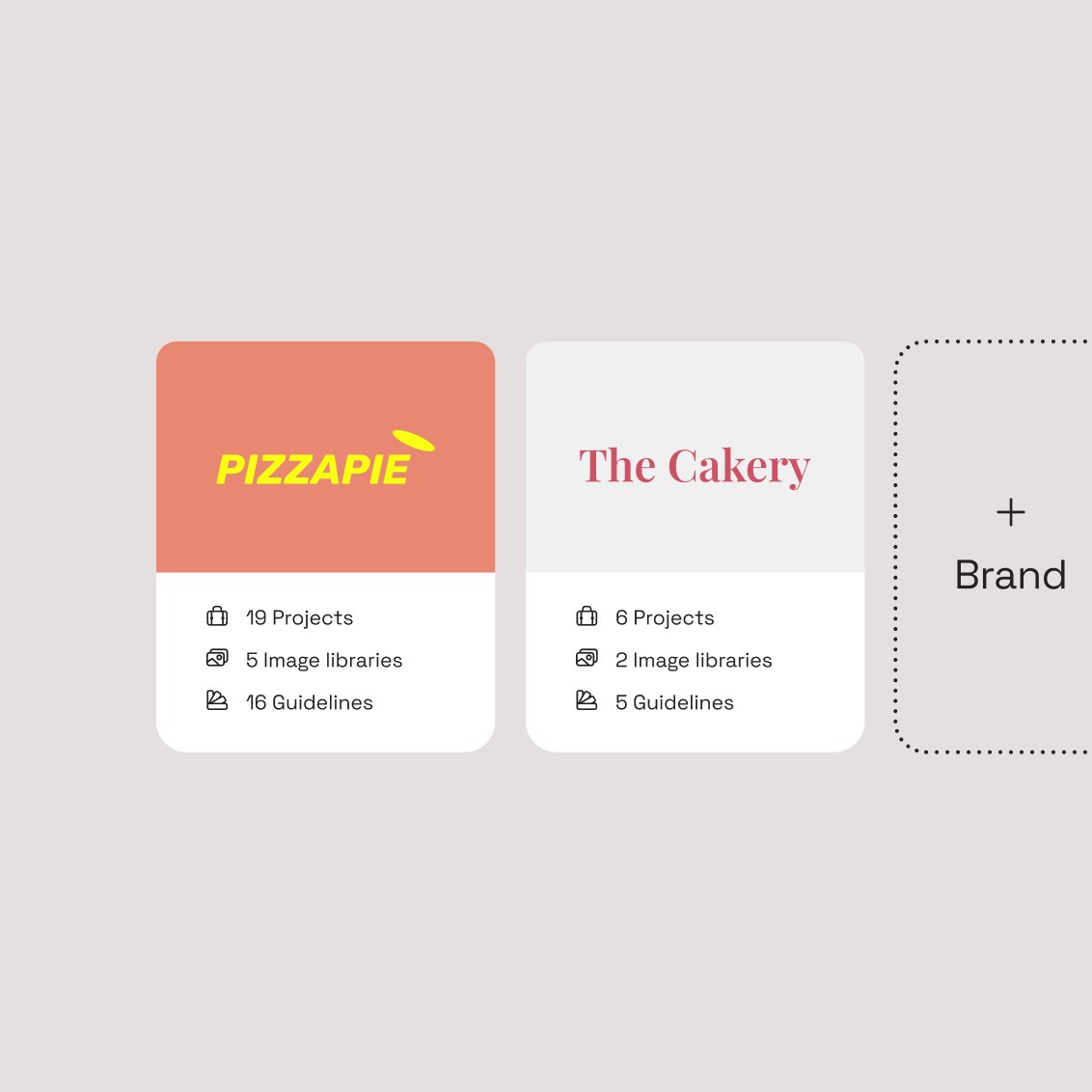A strong brand doesn’t happen by accident. It’s the result of deliberate, ongoing efforts to shape how people see and experience your brand. Brand management is about creating alignment between your brand’s purpose, identity, and how it shows up in the world.
Done right, brand management drives real business results. In fact, 62% of consumers say they’re willing to pay more for products and services from brands they trust, according to Salsify. Strategic brand management leads to stronger brand equity, deeper customer loyalty, and a lasting competitive edge.
What is brand management?
Brand management is the process of maintaining and improving the perceived value of a brand over time. An effective brand management strategy ensures that every interaction reinforces your brand values. By aligning everything brand-related — like visual elements, brand messaging, and customer experiences — it builds a strong brand identity, increases brand equity, and fosters long-term customer loyalty.
Managing all of your brand components to create a consistent image with your customers takes a coordinated effort from your entire organization. Over time, this consistency pays off. When companies like Uber use platforms like Frontify to streamline their brand management, they’re able to deliver a unified, on-brand experience across teams and regions, building brand recognition and loyalty that translates directly into brand equity.
The bottom line? When executed well, brand management translates directly into long-term revenue growth, market differentiation, and customer lifetime value.

Core elements of brand management
Successful brand management depends on a few key principles that help brands stay strong:
- Consistency: Aligning every touchpoint to build recognition and trust over time.
- Adaptability: Evolving your brand to meet shifting market demands and customer expectations without losing its core identity.
- Scalability: Equipping teams with systems and tools (like brand portals) that make it easy to maintain brand integrity as the business grows.
The importance of brand management: 3 key benefits
Effective brand management fuels long-term growth by helping brands build recognition, deliver consistent, high-quality experiences, and earn customer trust. It ensures that your brand shows up the same way across every touchpoint, from social media to in-store signage.
Without a strong brand strategy, customer experiences can become fragmented. That’s why many organizations turn to brand management platforms: to make it easier to create advertising templates, manage assets like brand logos, and collaborate with different departments and stakeholders.
1. Establishes and maintains consistent branding
Consistent branding makes it easier for consumers to identify brands when they encounter them in their day-to-day lives, whether that’s in an Instagram post, in a magazine ad, or on a product on the shelf at the local store. And in a recent report from Marq, they found that consistency can increase a brand's profitability by over 20%.
Brand management actively works to establish and improve consistency:
- Creates brand guidelines that document who a brand is and serve as a roadmap for how team members develop and maintain its identity
- Supports internal-team collaboration and keeps everyone on the same page, so that even large, global teams can use one unified brand voice.
- Establishes review processes for marketing and advertising efforts to ensure messaging and imaging remain on-brand.
While this might not seem like a big deal, nearly 80% of consumers in a Redpoint Global survey named inconsistent messaging as a pain point. And that means that even a seemingly minor issue like using the wrong language in a social media ad can hurt the brand in the long run.

2. Improves internal team efficiency
A resource repository is a key element of effective brand management and gives everyone in an organization access to the assets they need to represent the brand. And, because everything is in one location, it saves time by making it much easier to find the necessary files. One Frontify customer, Spring Health, has saved over 16 hours per template since adopting the platform.
A few teams that benefit from brand management include:
- Marketing: Marketers need access to a variety of assets to connect with consumers across all platforms. This includes formatted logos for social media platforms and content calendars that guide marketing campaigns.
- Design: Designers create new templates and visuals for web pages and ads. But to maintain consistency with older designs, this team needs a wide variety of resources, including previous templates for comparison, codes for branded color palettes, and font and style preferences.
- Sales: Sales is one of the only internal teams that interact directly with customers at a personal level, which means that they need to know how to talk about the brand. And they need to be aware of what marketing promotions are happening and what language to use when talking about products, all of which they can find in the brand’s resource repository.

3. Drives customer engagement and encourages brand loyalty
Loyal customers are proven to be more valuable to brands over time because they make larger purchases. And the longer they stay loyal, the more frequently they make purchases. It’s also more cost-effective to retain than acquire: studies have historically shown that acquiring a new customer may cost your brand five to seven times more than retaining a current customer. Brand management helps drive customer support and boost revenue by creating more positive experiences and making brand aspects they care about easier to identify.
Take Patagonia as an example: The outdoor and apparel company doesn’t just make great products that its customers love. Patagonia also promotes its dedication to sustainability with everything it does — from posting educational videos about sustainable materials on Instagram to donating a percentage of its profits to preservation and restoration efforts. And thanks to its successful branding efforts, Patagonia is regarded as one of the most reputable brands in the US and does more than USD 200 million in annual sales.
The role of technology in brand management
Technology has become the foundation of modern brand management. As teams juggle global campaigns, real-time content creation, and expanding digital touchpoints, brand management platforms help maintain consistency and control at scale.
Cloud-based systems like brand portals and digital asset management (DAM) systems do more than store files; they centralize brand guidelines, manage version control, and automate approval workflows. This technology ensures that every team, from marketing to sales, is working from the same playbook, no matter their location or function.
AI is also changing how brands operate. It can detect off-brand content before it goes live and even generate on-brand design or copy suggestions. These capabilities reduce manual work and help brand teams focus on higher-impact decisions.
With the right tech stack in place, brand managers and marketers can spend less time chasing consistency and more time building equity.

6 steps to create an effective brand management strategy
A successful brand management strategy supports your broader marketing strategy by aligning visuals, messaging, and experiences. Just like people, brands are unique. And that means there isn’t a universal approach to brand management. But there are a few best practices that every business should follow to create a consistent image that accurately reflects its values:
1. Define your brand goals
Define your brand goals, which could be anything from boosting awareness to establishing your brand as a household name. Then, you’ll need to identify the tactics to reach your goals. The more specific you are throughout this process, the better prepared you’ll be to make decisions about the brand in the future.
For example, if your brand is relatively new and struggling with recognition, a clear goal might be to increase brand awareness by 15% in your target market within 12 months. To arrive at a goal like this, start by identifying where your brand currently stands, what success looks like, and how you’ll measure it.
2. Evaluate your brand positioning and identity
Evaluate the brand’s current position to ensure any future branding efforts build on the success of the existing brand.
Start by conducting a brand audit and doing a competitor analysis. A brand audit typically includes reviewing your visual identity, messaging, customer feedback, and marketing performance. A competitor analysis looks at how similar brands position themselves, what messaging they use, and how your shared audience perceives them.
This market research will give you a better understanding of what customers like about your brand and what they’d like to see in the future.
3. Create brand guidelines
Traditionally, brand guidelines were a single PDF document containing details on how to size the company logo, what tone of voice to use, and when and how to use stock photography. The most successful brands nowadays rely on the cloud to create a living document that gives everyone access to the same basic guidelines and resources.
A centralized approach makes it easier to maintain brand consistency across teams, channels, and markets, so every piece of content you publish reflects the same core identity.
4. Align and empower your teams and stakeholders
To execute your brand strategy effectively, your teams need clear direction on how to represent the brand. Once your strategy and standards are defined in your guidelines, the next step is to empower teams to apply them confidently and consistently in their day-to-day work.
Share access to your guidelines with everyone so they can easily create on-brand content — from brand marketing campaigns to sales decks — without needing to consult designers for every asset. Use training sessions, to show them how to use the guidelines, and collaborative tools to streamline content creation.
5. Monitor brand performance and perception
Using brand management software, like a digital asset management system, enables you to streamline processes, store resources for easy access, and automate performance monitoring. This makes branded assets easier to find and reduces the time it takes to generate performance reports.
To fully understand how your target audience perceives your brand, identify key metrics to track, run brand health surveys, and monitor mentions and sentiment on social media and review platforms. Use your brand management platform to track internal asset usage and consistency, and tools like Google Analytics or social listening platforms to measure external brand visibility and audience perception.
6. Adapt and evolve your brand over time
Your brand isn’t static. Customer expectations, market trends, and business priorities change.
To stay relevant, schedule regular brand reviews to assess what’s working and where updates are needed. Refresh your guidelines when necessary, and use tools like a DAM system to distribute changes quickly and consistently across all teams.
How to master brand governance
Consistent branding depends on strong brand governance. Without clear oversight, it’s easy for teams to go off-brand, especially as your company grows or expands globally.
A digital brand platform makes governance more manageable by centralizing control. Tools like approval workflows, role-based access, and version control help you enforce standards without slowing teams down.
With Frontify, you can automate updates to brand guidelines, track usage, and even surface insights with AI to spot inconsistencies early. Datacom, for example, uses Frontify to centralize over 45,000 brand assets and guidelines, eliminating version control issues and ensuring everyone across the organization works from a single source of truth.
Check out our brand governance report to learn about effective brand governance in the age of marketing transformation.
Examples of brand management
You already know what successful brand management looks like because you’ve seen some of the most successful companies in the world do it:
Kia rebranded thanks to internal alignment
When Kia rebranded in 2021, one of the biggest challenges wasn’t the design — it was getting their teams to adopt a new brand mindset.

With Frontify, Kia centralized brand guidelines and assets in one hub, making it easy for teams to collaborate, access materials, and stay aligned. The result? Stronger internal ownership, faster rollout, and more consistent brand execution across every market.
Takeaway: Brand management platforms help turn internal teams into brand champions, especially during major transitions like rebranding.
Kansas City Chiefs manage a complex brand at scale
When the NFL team, the Kansas City Chiefs, expanded into new markets and managed dozens of brand touchpoints, their biggest challenge was maintaining brand consistency without slowing teams down.

With Frontify, the Chiefs centralized over 200 logo files and brand assets into one platform, making it easy for internal teams and external partners to find, use, and stay aligned on the brand. This initiative resulted in smoother collaboration, time savings, and a more cohesive brand presence across all channels.
Takeaway: A modern brand management platform streamlines collaboration and safeguards brand consistency, even when your brand spans teams, markets, and media channels.
Uber became a verb
The rideshare leader, Uber, made its catchphrase, “getting an Uber,” so common that it’s now universally known and associated with ride-sharing services. And Uber was able to do this because it built its brand around its most-loved aspect: the convenience with which its users can “get an Uber.”

With Frontify, Uber created a centralized brand hub used by over 20,000 team members. It helped reduce complexity, streamline collaboration, and ensure that every message, in every market, felt unmistakably Uber.
Takeaway: With the right tools, even the fastest-growing companies can continue to scale globally without losing what makes their brand iconic.
Create a global, consistent brand identity with Frontify
Building and maintaining brand consistency is no easy task, especially if your company is operating across multiple markets and time zones. That’s where a digital asset management platform like Frontify comes in. Frontify helps global teams stay aligned while allowing for local flexibility by centralizing your brand assets, guidelines, and tools in one accessible hub.
Book a demo to see how Frontify can transform your brand management strategy.


